
"Campus to Coast is a paddle sport adventure race put on by the Michigan State University Outdoors Club. The race starts on MSU’s campus at the Rock, following the Red Cedar River into the Grand River and out through Grand Haven, finishing at Grand Haven State Park. The race is approximately 160 miles, with estimations of the fastest times being anywhere from 26-40 hours, depending on the river conditions, and 57 hours being the cut-off time. This race also contains 7 portages, along with one section where racers must “canoe line” a small section of fall over dams."
Campus to Coast was recently rated as #9 on a list of the Top 25 Ultra-Distance Paddling Races In North America compiled by Rod Price.
The conditions
All of our gear was piled on the living room floor on Thursday night before the start when the tornado warning sirens went off. My cell phone piped up with an NWS emergency weather alert indicating that a tornado would hit Ypsilanti within the next 30 minutes. I didn't know my phone could do that. We had no basement, so we considered sheltering in the bathroom, but that wasn't much better than the living room, so we continued going through our checklist. I even got the unexpired flares out of the garage so that we would have all the required gear.
The severe storms were forecast to move through Thursday night. The remains of the system would leave cold temperatures, rain, and high winds from the west (headwinds) for the first day of the race on Friday. Skies were forecast to clear on Friday night, leading to lows below freezing, but conditions would improve with relatively warm and sunny conditions for Saturday and Sunday. River levels were below normal, but with several days of rain in the week preceding the start, the Grand River was rising to normal or above normal levels. However, the river would still be lower and slower than last year, when it was receding from flood stage.
Let's do this!
The start was moved three miles upstream to Wonch Park this year because MSU decided not to allow the event to start from the traditional location of "The Rock" on campus.
The temperature was a chilly 40 degrees, the wind whipped in the treetops, and it was spitting rain. There is a certain excitement in exposing ourselves to nature. Over the next 32-40 hours, we would be in the canoe. Whatever mother nature threw our way, we would endure it and continue paddling.
Our plan was similar to last year; try to get past Lyons by dark and pass the night time hours on the flat waters between Lyons and Grand Rapids. In the Krugerhead 340 last July, we had passed 44 hours in the canoe in relative comfort, having developed methods to cook a hot meal in the boat and sleep for a few hours at a time. Last year in the Campus to Coast, we attempted to get by on cold food and 20 minute naps. This time we would cook a hot meal after Lyons and try to take turns sleeping for two hours each while the other paddled.
Ben paddled solo in his Sea Wind. He showed off his supply of eight Red Bulls, leftovers from his unused supply in the cancelled 2015 Everglades Challenge.
Mike and Sandy teamed up in Mark P's Kruger Cruiser "Big Medicine".
Mark P. had decided to team up with Jack "The Hammer" again, but sadly had to cancel at the last minute because he came down with a nasty cold.
We did not know it at the time, but the turquoise canoe parked beside our Cruiser would play an important role in our adventure.
Luke Rookus led the MSU Outdoor Club student organizing team this year, and gave us some final tips at the captain's meeting.
Go!!!
We briefly ran alongside Ben toward the river towing our boats, with Emily running ahead to snap photos. After a few steps, we got tired and walked.
Photo credit: Emily Algera
After a few miles on the Red Cedar, we passed through MSU campus. The turquoise canoe came up from behind and overtook us at The Rock. We took pictures of each other as we passed, and Rick remarked that we had the same camera. They were a father and son team.
Photo credit: Rick Waldo
Students walked to their morning classes as we pulled into the headwind.
Photo credit: Rick Waldo
They had a light, fast Wenonah Escape, which they paddled with enthusiasm, and pulled away as we passed The Rock. Moving the start upstream to Wonch Park added 35 minutes of paddling.
We portaged the low-head dam on campus and pulled around two log jams on the Red Cedar.
Emily waved from a bridge as we pulled away from the last logjam.
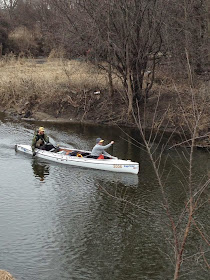
Photo credit: Emily Algera
After a few hours paddling on the Red Cedar, we arrived at the Grand River in Lansing. We began to feel the wind more as the river opened up. Strong gusts occasionally pushed against us and we had to dig-in to keep going forward.
We fondly remembered our adventure with the Rudderless Renegades in the Dragon Boat Race from last summer.
Our portage buddies were with us at Turner Park in Lansing, as they were on each portage until we pulled away from them after night fall at Wagar Dam.
Mark P. came to see us at the portages through Grand Ledge.
The west wind was powerful. Much of the time we were sheltered, but on open stretches the gusts some times pushed us back.
Windy day
The pretty blue water tower at Grand Ledge is always a welcome sight. Some day we will have to stop at the Lickety Split ice cream shop next to the bridge. Mark P. told us how he used to stop there after paddling with Verlen on the Grand.
Grand Ledge
Luke Rookus posted the picture of chicken salad snack from our blog last year on the Campus to Coast Facebook site, which made me hungry. So we made a trip to the canned meat aisle at the grocery store to get some. It took some searching to find it because they changed the box, but it's the same tasty stuff inside.
A carpet of green was sprouting on the forest floor. They will be wildflowers in a few weeks when we pass by on the Hugh Heward.
We looked for the eagle on river right as we approached Portland. We thought maybe we could see it on the nest.
Emily, John, and Roxanne waved to us from the Verlen Kruger Memorial in Portland. We had just completed a 50-mile Hugh Heward, and felt like we had put in a good long day of paddling. But we were just getting started on the Campus to Coast. It had begun to rain and the temperature was dropping.
Rain continued as we approached Portland Municipal Dam.
We had hoped to make it to Lyons by sunset, as we did last year, but the headwinds set us back a few hours. It was raining and the sun was setting as we portaged at Portland Dam. We decided to go ahead and prepare for night mode. We put on fleece layers under our rain gear, attached the spray cover and the headlight, and got out the food bag so I could cook dinner after Lyons.

A DNR officer leaned over the rail and chatted with us as we awkwardly put on our fleece layers in the rain. "Nice weather for it" he remarked, after we told him we would be paddling through the night.
The sun set and the rain continued as we paddled the short section to Webber Dam.
Webber Dam is a tall one. Last year we tried to roll the canoe down the steep grass slope on the wheels and it almost got away from us. This year we rolled it down the stairs, which was a little scary at first, but worked OK.
Our portage buddies were just ahead, navigating the fast water below the dam that pushes into an overhanging willow tree. We launched pointed upstream and ferried across before turning to head down.
We were greeted by smiling faces at Lyons. These two volunteers had their hammocks set up for a long, cold night.
We wheeled through town in Lyons so we would not have to hoist the canoe over a guardrail.
It was midnight when we launched from the park in Lyons. It occurred to me that midnight is not really the middle of the night. It had been dark for four hours, but it would be seven hours before first light.
The headwinds put us about four hours behind schedule from last year, so we were late for dinner. I fired up the jetboil as Lauren paddled us downstream. I fixed Mountain House lasagna for me and Alpine Aire mesquite bbq chicken for Lauren. The hot meals really hit the spot.
The sky cleared. I was happy that the rain stopped, but the clear sky would mean a cold night. This was in the forecast, so we were expecting it.
For some reason, I was feeling alert after dinner. I volunteered to let Lauren take the first two hour sleeping shift. I knew that my alert feeling would not last. We had been paddling for 17 hours, and I was feeling sore and tired.
Sleepy time
What warmth there was from the chilly day was being sucked away from the earth by the cold vacuum of space. Whisps of fog began to rise from the river. I would have turned off the headlight, but it was well out of reach. Lauren was snoring away down below. I tried to stay quiet so that she could make the best of her sleep time.
It was very difficult to stay awake. My brain was checking out. Fortunately, the river was wide and flat all the way to Grand Rapids, and we knew that there were no major obstacles. The whisps of fog passing through the headlight were mesmerising. It looked like the headlight was a fog machine in a movie that was playing in reverse. I began to hallucinate objects in the light, shadows, and fog.
Micheal Doty and Stacy Smith gained five hours on us through the night last year in the Campus to Coast. I asked Micheal for some tips on staying awake. What I took away was, 1) drink coffee, 2) keep your mind occupied with math problems and time-distance calculations, and 3) if all else fails, paddle harder. I tried each of these tactics. We had a thermos of hot coffee, but it made little difference. I tried some math problems, but I couldn't keep the numbers in my mind long enough to do any calculations. I tried paddling harder. Doing a sprint woke me up for a few minutes, but then it was back to the same situation. I think it just comes down to having a strong enough will to win to keep the adrenaline pumping.
After 1.5 hours, I could no longer keep my eyes open. I pulled off to the side, tied the stern line to a log, laid back, and set my watch alarm for ten minutes. Lauren was still snoring when I woke up; she never had to know!
At 3AM, Lauren's sleep shift was up, and it was my turn to lay down. In the MR340, we popped the seats out and slept in the bottom of the boat. It was pretty comfortable in that case, but it was warm and we had less clothes. This time it was rather cramped down there with all the warm layers. It was quite cold and wet, but it felt very good to lay down. I did my best to spread the space blanket over me, but there was so little space that I didn't do a very good job.
Mental note: when you do a selfie video with a red headlamp on, it looks like the Eye of Sauron from the Lord of the Rings movie.
At 4:30 AM my toes were getting cold, so I cut my sleep shift a half hour short and got up to paddle. An hour of sleep might not sound like much but it makes a big difference.
A pale glow
The waning quarter of a moon was rising as I picked up the paddle. Owls hooted in the dark woods along the river. The fog was much thicker now. Lauren had turned off the headlight. We could just make out the dark trees on each side of the river so we could stay in the middle to avoid obstacles, but ahead we could only see the pale diffuse glow of the moonlit fog. I paddled hard to warm up.After some time, we spotted a red light ahead in the fog. At first we could not tell if it was on land or on the water. As we got closer it was clear that it was on the water. We figured it must be a boat. Finally, we were within a few feet and realized it was the turquoise canoe! "Wow, you guys are fast!", Lauren said. "We would be a lot faster if I could get this guy to wake up", Rick said, pointing his paddle toward the inanimate figure slumped back over the bow seat. We passed them doing our best to look strong, vigorous, and not tired at all.
Close encounters of the beaver kind
Lauren related a story of a close encounter with a beaver family while I was sleeping. It went something like this:
Once upon a time, there was a beaver family living under the water. One night, there was a big commotion. A giant white creature was moving ominously over the beaver pond. Big Mamma Beaver swam up to Big Pappa Beaver and said, "Big Pappa Beaver, there's a giant white monster cruising over our pond!." To which Big Pappa Beaver said, "waat" (that's what beavers say, by the way). The giant white thing kept moving over the pond. Big Mamma Beaver decided to take action and called all the little beaver brothers and sisters and beaver cousins. She told them, "waat." That's what beavers say, after all. What she really meant was, "let's all swim around that giant white thing and give it a scare." They all swam in a circle around the giant white thing and said "waat" (that's what beavers say, after all). Then, on the count of three ("Waat" Waat" Waat"), they all raised their tails and went "WHACK" around the white thing (that's what beavers do after all). The white thing must have been scared, because it kept moving out of the Big Beaver family pond. After that all was good for the Big Beaver Family, and they crawled back into their mud burrows in the bank.
Shortly after the beaver story concluded, the turquoise canoe appeared out of the fog next to me and startled me awake from a sleepy moment. "Oh, hi guys", I said. They cruised on past looked vigorous and not tired at all. Our time in the lead was short lived.
Dawn
Dawn finally arrived at 7 AM with choruses of cheerful birds. We eagerly anticipated the warmth of the sun to melt the ice off the spray cover, and to thaw our frozen fingers and toes.I always hope that the sun will wake me up and wipe away the lack of sleep from the night before, but a little sun does not erase a sleepless night of paddling. We battled the sleepies as the river took a long bend on the approach to Grand Rapids.
Last year we put in just below the 6th Street dam, and had to battle the crowd of salmon fishermen and the rapids. This year, we tried a longer portage that we had scouted on a road trip during the winter. Clinton told us that the turquoise canoe landed a half hour ahead of us, but they were taking some time on the portage. He said we could catch up.
As we crossed the river at Bridge Street, we saw the turquoise canoe launch and head downstream on the fast current. We were only a few minutes behind them! You can just see them under the bridge in the picture below.
Kick it!
After passing Grand Rapids, we felt like we were in the home stretch. Lauren was excited to kick it in to the finish and reel in the turquoise canoe. It's funny how perceptions of distances are relative; we still had 35 miles to go and it would take us another seven hours. It was noon, so we hoped to finish in time for dinner.Aunt Marlene and Uncle Larry missed us at Grand Rapids because we forgot to reset our Spot when it turned off after 24 hours. They caught up to us a little further downstream and took some pictures. It really lifted our spirits to see them.
Photo credit: Marlene Fry
We stayed focused in an effort to reel in the turquoise canoe. As a result, I was not my normal shutter-bug self, and did not take any pictures. We played the four-letter-word game to keep our minds from falling asleep and put in some focused paddling.
On river left there was a crowd of people gathered at a rowing club getting ready to practice. They actually knew that we were battling for first place in a canoe race from Lansing to Grand Haven, and gave us a cheer. We heard someone say, "They have been paddling since Friday morning".
The red ball
A man yelled something at us from the left bank as we passed a campground. I stopped paddling for a moment to hear what he was saying. He said that his boy's ball got away from him and was blown across the river by the wind, would we retrieve it for him? We looked to the right and saw a red ball. The river was wide at this point, it probably would have taken two minutes to retrieve the ball, take it to them, and get back underway. Lauren instantly answered, "sorry we're racing that canoe that just went by", and we kept paddling. The father called out in exasperated frustration, "that canoe that's a half mile ahead?" In his mind perhaps that was an insurmountable lead.I looked at the ball as we paddled past. It was a big one, maybe 24 inches. It glowed bright red in the warm light of the evening sun, pressed against the brown dead grass by the stiff breeze. A boy would have a lot of fun playing with a ball like that. It was a moral dilemma. I was a little bit ashamed that we just kept paddling, but they could not understand what we had just been through to be in this position! We were maybe ten minutes from the lead canoe. We would keep the pressure on them, and if they took a break or a wrong turn, we could win this thing! We later found out that Rick and Dale also passed up the opportunity to retrieve the red ball! Hopefully another boat came along to rescue the ball. The boy will probably grow up to hate canoeists.
The finish
We could just make out the turquoise canoe in the distance. It looked very similar to one of the navigational buoys marking the channel on the lower river, but the occasional flash of a paddle reflecting the low evening sun gave them away.Maybe if they missed the cut through the marsh, we could pass them. We could not see whether they had taken the cut. A fisherman was on the bank at the park at the entrance to the cut. "You're the second canoe that passed, what's going on?", he called out. "We're racing that canoe to Grand Haven!". When two canoes appear to be in a race, every person along the river will tell you just how far ahead the other canoe is. Everyone loves a race. He said they were five minutes ahead. Five minutes! We were gaining. However, we knew that they took the cut. We later learned that they had read our blog, so we gave away all our secrets.
We had marked waypoints through the braided channels of the marsh from Google Earth. However, the marsh grass changes by the season, so it was not clear that the channel we picked would go through. If we made a navigational error at this point, all hope of catching the turquoise canoe would be lost. There was enough current pulling us through this channel that it must come out somewhere.
Finally, we emerged from the marsh and turned toward Harbor Island. It was barely visible across a large stretch of open water. We could see them! Lauren said we should sprint to catch them. We swept the cobwebs from our brains and muscles and began pulling hard. As we reeled them in, we could see their paddles. They were not paddling fast; they did not even know we were there! The finish was in a different place this year, and I was not totally sure of the way. If they took a wrong turn, we could catch them. They turned to the north after passing under the draw bridge. A few minutes later, they reappeared. They had taken a wrong turn! Now we were close. All the drowsiness was gone from our brains; now we were sprinting for real! But they finally saw us, and began sprinting themselves. They pulled up to the dock two minutes ahead of us.
To the coast
Tim, Clinton, Luke, and the other race organizers were there to meet us at the dock. We congratulated Rick and Dale on a great race. Dale wanted to paddle out the breakwater on Lake Michigan and finish at the beach. An hour earlier all I wanted to do was lay down and close my eyes, but the excitement of the sprint to the finish woke me up. I wanted to paddle to the beach with Rick and Dale.Clinton drove to the beach to check the ice situation. He called back that the way was open, so we got into the canoes and paddled toward the setting sun.
Rick and Dale told us some stories. The had paddled the entire Mississippi River together two summers ago. Last summer Dale had paddled the entire Missouri River from its source to Saint Louis. These two had paddled many miles together and knew how to live in a canoe. We shared a bond having paddled through the wind, rain, fog, darkness, cold, and beauty of the previous 35 hours together.
Photo credit: Rick Waldo
The swells from the lake lifted our canoes. The lighthouse was still encrusted with ice. The water of Lake Michigan was so cold that the heat was conducted from our paddles, and the air over the water was so cold that our hands became numb over the short paddle to the beach.
Lighthouse
We finished the Campus to Coast at the beach, just as Tim Muhich originally envisioned the event. Tim met us at the beach with our car and helped us load up our gear. We were lucky to arrive just in time for a spectacular sun set.
Stats from the GPS
159 miles
32 hr 56 min moving time
2 hr 50 min stopped time
7.9 mph max speed
4.8 mph moving average
4.5 mph overall average
Weather observations
Here are the weather conditions observed at Lansing for the week including the race start on Friday morning. There are several features to note: 1) the low pressure system that moved through early Friday morning just before the start, 2) Temperature of 40 F at the start, increasing only to 50 F on Friday before dipping to below freezing in the wee hours of Saturday morning, 3) West winds of 20-30 mph with gusts of 25-45 mph, 4) on Saturday, winds were West at 10-15 mph with gusts of 20-25 mph.
River level
This year, the Grand River at Ionia was rising from below normal levels to near normal at the race start on April 10.
Last year, Grand River was declining from flood stage, and still well above normal flow.
This year, when the sun rose on the approach to Grand Rapids, we noted that the river had risen overnight; it was muddy with floating sticks and logs, and was at bank-full flow.
Last year, the river was receding from near flood stage. After looking at the data, it appears that the river near Grand Rapids was actually higher in 2015 (11,000 cfs on April 11) than in 2014 (9,000 cfs on April 12).







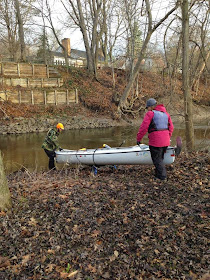




















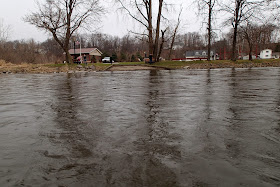
















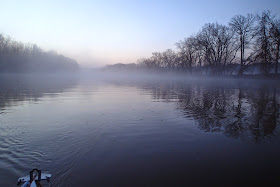


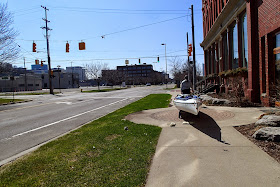


.JPG)
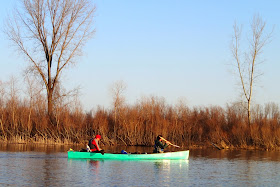












No comments:
Post a Comment